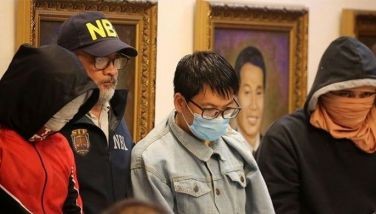DOLE: Jobless youths reach 2.5-M
January 12, 2004 | 12:00am
The number of jobless Filipino youths has reached 2.5 million and will likely increase this year, the Department of Labor and Employment (DOLE) reported yesterday.
Even as DOLE admitted the rising unemployment rate, Senate President Franklin Drilon called on the government to develop a master plan that would generate more jobs for the swelling ranks of the unemployed.
Drilon said DOLE must come up with a comprehensive plan that would arrest the increasing number of jobless Filipinos due to the decrease in the availability of overseas jobs.
A study undertaken by the DOLE-Bureau of Labor and Employment Statistics (BLES) showed that the number of unemployed Filipino youths has been fast increasing for the past five years.
Results of the study indicated that jobless youths belonging to the 15 to 24 age group rose from 2.01 million in 1998 to 2.5 million in 2002.
Most or three out of five unemployed youths were males living in urban areas. Half of them have completed high school while those who had completed college education comprise 39.5 percent of the group.
The high youth unemployment was attributed to their being unqualified for the job market owing to their lack of skills or training while the others are simply too lazy to work.
Based on the research, only one-third of the total number of unemployed youths actually engaged in job hunting despite the greater number of respondents who signified their interest to look for a job.
Labor officials explained the disparity was due to the inability of most youths to fit the available jobs due to lack of requirements or being unskilled for a particular type of work.
Officials cited the results of the recently concluded "Kasama ka Kabataan" jobs fair which revealed more than half of the applicants were not qualified for the job openings.
The studies also show that the length of time spent by young job seekers went up from 7.2 weeks in 1998 to 8.5 weeks in 2000. The duration of job search extends longer as the applicants grow older.
The same study revealed that less than five percent of the unemployed youths sought government assistance despite DOLE’s efforts to help them through public employment agencies.
The most common method is to directly approach prospective employers while others rely on tips from relatives or friends for job openings, whether domestic or abroad.
Drilon said a recent report made by the Commission on Filipinos Overseas (CFO) revealed that the number of registered Filipino migrant workers declined by eight percent to 31,543 in the first six months last year compared to 129, 022 in the same period in 2002.
"What is more alarming is that the emigrants belonging to the class of professionals, including technical workers, have declined by 18.7 percent from 4,967 to 4,038 during the same period. The professional group includes nurses, teachers, computer programmers and engineers," Drilon said.
In the face of these developments showing a decline in the number of overseas jobs available to Filipinos, Drilon stressed DOLE and other related government agencies should now draw up contingency plans to provide more jobs for the unemployed in our country.
"If this trend continues, we would expect our unemployment rate, which currently stands at 13 percent, to swell further. It would also mean less income for the country from overseas remittances," he said.
Drilon sees the continuing trend in the future citing the spate of violence rocking the Middle East region, particularly in Iraq and Israel, as well as the growing tension in Saudi Arabia caused by recent terrorist attacks.
"The exodus of manufacturing industries from industrialized countries like the United States, Japan and the European Union to China, where there is a large pool of unemployed workers from the rural areas, also threatens the traditional sources of overseas jobs for Filipinos," Drilon said.
The Senate leader said that government could step up its support for the establishment of small and medium industries to absorb more workers.
He said this has been done in Thailand where its government was able to generate more jobs by providing financial and credit support to small and medium scale industries.
"The government should start planning seriously to create more domestic jobs for our workers in coordination with the private sector. If we don’t want unemployment to worsen and possibly threaten to further destabilize state and society in our country," Drilon said.
Drilon also urged the government to step up efforts to attract more foreign investments in manufacturing industries through joint venture to open up more employment opportunities.
"However, a long term solution would be the adoption of an industrialization program that would modernize the economy through mechanization and the employment of high technology in industrial production. At any rate, we must do some hard thinking to cope with a serious social problem that this would bring," Drilon said. -With Jose Rodel Clapano
Even as DOLE admitted the rising unemployment rate, Senate President Franklin Drilon called on the government to develop a master plan that would generate more jobs for the swelling ranks of the unemployed.
Drilon said DOLE must come up with a comprehensive plan that would arrest the increasing number of jobless Filipinos due to the decrease in the availability of overseas jobs.
A study undertaken by the DOLE-Bureau of Labor and Employment Statistics (BLES) showed that the number of unemployed Filipino youths has been fast increasing for the past five years.
Results of the study indicated that jobless youths belonging to the 15 to 24 age group rose from 2.01 million in 1998 to 2.5 million in 2002.
Most or three out of five unemployed youths were males living in urban areas. Half of them have completed high school while those who had completed college education comprise 39.5 percent of the group.
The high youth unemployment was attributed to their being unqualified for the job market owing to their lack of skills or training while the others are simply too lazy to work.
Based on the research, only one-third of the total number of unemployed youths actually engaged in job hunting despite the greater number of respondents who signified their interest to look for a job.
Labor officials explained the disparity was due to the inability of most youths to fit the available jobs due to lack of requirements or being unskilled for a particular type of work.
Officials cited the results of the recently concluded "Kasama ka Kabataan" jobs fair which revealed more than half of the applicants were not qualified for the job openings.
The studies also show that the length of time spent by young job seekers went up from 7.2 weeks in 1998 to 8.5 weeks in 2000. The duration of job search extends longer as the applicants grow older.
The same study revealed that less than five percent of the unemployed youths sought government assistance despite DOLE’s efforts to help them through public employment agencies.
The most common method is to directly approach prospective employers while others rely on tips from relatives or friends for job openings, whether domestic or abroad.
Drilon said a recent report made by the Commission on Filipinos Overseas (CFO) revealed that the number of registered Filipino migrant workers declined by eight percent to 31,543 in the first six months last year compared to 129, 022 in the same period in 2002.
"What is more alarming is that the emigrants belonging to the class of professionals, including technical workers, have declined by 18.7 percent from 4,967 to 4,038 during the same period. The professional group includes nurses, teachers, computer programmers and engineers," Drilon said.
In the face of these developments showing a decline in the number of overseas jobs available to Filipinos, Drilon stressed DOLE and other related government agencies should now draw up contingency plans to provide more jobs for the unemployed in our country.
"If this trend continues, we would expect our unemployment rate, which currently stands at 13 percent, to swell further. It would also mean less income for the country from overseas remittances," he said.
Drilon sees the continuing trend in the future citing the spate of violence rocking the Middle East region, particularly in Iraq and Israel, as well as the growing tension in Saudi Arabia caused by recent terrorist attacks.
"The exodus of manufacturing industries from industrialized countries like the United States, Japan and the European Union to China, where there is a large pool of unemployed workers from the rural areas, also threatens the traditional sources of overseas jobs for Filipinos," Drilon said.
The Senate leader said that government could step up its support for the establishment of small and medium industries to absorb more workers.
He said this has been done in Thailand where its government was able to generate more jobs by providing financial and credit support to small and medium scale industries.
"The government should start planning seriously to create more domestic jobs for our workers in coordination with the private sector. If we don’t want unemployment to worsen and possibly threaten to further destabilize state and society in our country," Drilon said.
Drilon also urged the government to step up efforts to attract more foreign investments in manufacturing industries through joint venture to open up more employment opportunities.
"However, a long term solution would be the adoption of an industrialization program that would modernize the economy through mechanization and the employment of high technology in industrial production. At any rate, we must do some hard thinking to cope with a serious social problem that this would bring," Drilon said. -With Jose Rodel Clapano
BrandSpace Articles
<
>
- Latest
- Trending
Trending
Latest
Trending
Latest
Recommended































